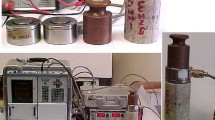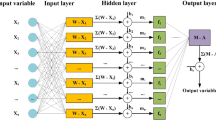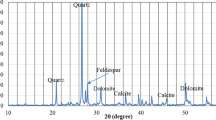Abstract
The strain developed due to creep is mainly proportional to the logarithm of the time under load, and is mostly proportional to the stress and temperature. At higher temperature the creep rate falls slowly with respect to time, and the creep strain is proportional to a fractional power of time, with the exponent increasing as the temperature increases and reaching a value approximately one-third at temperatures of about 0.5°C. At these temperatures, the creep increases with stress according to a power greater than unity and possibly exponentially. It increases with temperature as (−U/kT), where U is an activation energy and k is Boltzman’s constant. There are different methods to determine the creep strain and the energy of Jog (B) including experimental methods, multivariate regression analysis, and by numerical simulation. These methods are less cumbersome and time consuming. In the present investigation, artificial neural network technique has been used for prediction of the creep strain and energy of Jog (B). Two different networks have been tested and validated. Both the networks have four input neurons and one hidden layer with five neurons, and one output neuron. The data for different rocks at temperatures up to 750°C under conditions of compressive or tortional stress are taken from the literatures. The training and testing data sets used were 163 and 14, respectively. To deal with the problem of overfitting of data, Bayesian regulation has been used and network is trained with suitable training epochs. The coefficients of correlation among the predicted and observed values are found high and they improve the confidence of the users. The mean absolute percentage error obtained are also very low.






Similar content being viewed by others
References
Carter NL, Hansen FD (1983) Creep of rock salt. Tectonophysics 92:275–333
Chen WZ, Zhu WS, Shao JF (2004) Damage coupled time dependent model of jointed rockmass and application to large underground cavern exacavation. Int J Rock Mech Min Sci 41:669–1–677
Hertzberg RW (1989) Deformation and fracture mechanics of engineering materials, 3rd edn. Wiley, New York
Hirth JPJ, Lothe (1982) Theory of dislocations, 2nd edn. Wiley, New York
Hoffer KH, Knoll P (1971) Investigations into the mechanisms of creep deformation in carnallitite and practical applications. Int J Rock Mech Min Sci 8:61–73
Jaeger JC, Cook NGW (1979) Fundamentals of rock mechanics. Chapman and Hall, New York, p 593
Jang JSR, Suni CT, Mizutani E (1997) Neuro-fuzzy and soft computing. A computational approach to learning and machine intelligence. Prentice Hall, New York
Kosko B (1994) Neural networks and fuzzy systems: a dynamical systems approach to machine intelligence. Prentice Hall, New Delhi
Kranz RL (1979) Crack growth and development during creep of Barre granite. Int J Rock Mech Min Sci 16:22–35
MacKay DJC (1992) Bayesian interpolation. Neural Comput 4(3):415–447
Mishra AK, Murrel SAF (1965) An experimental study of effect of temperature and stress on the creep of rocks. Geophys J 9:509–539
Mott NF (1956) Creep and fracture of metals at high temperatures. In: Proceedings of NPL symposium HMSO, London, pp 21–24
Munson DE, Dawson PR (1981) Salt constitutive modeling using mechanism maps. In: 1st conference of mechanical behavior of salt, Pennsylvania State University, PA, pp 717–737
Nauck D, Klawonn F, Kruse R (1997) Foundations of neuro-fuzzy systems. Wiley, New York
Okubo S, Nishimatsu Y, Fukui K (1991) Complete creep curves under uniaxial compression. Int J Rock Mech Min Sci Geomech Abstr 28:77–82
Rzhevisky V, Novik G (1971) The physics of rocks. MIR, Moscow
Scholtz CH (1968) Mechanism of creep in brittle rock. J Geophys Res 73:3293–3302
Simpson PK (1990) Artificial neural system—foundation, paradigm, application and implementations. Pergamon Press, New York
Singh DP (1975) A study of creep of rocks. Int J Rock Mech Min Sci Geomech Abstr 12:271–276
Singh DP (1982) A study of time dependent properties of Mandi rock Salt. In: National seminar in mechanics mining ground, India, pp 205–210
Singh DP, Bamford WE (1971) The prediction and the measurement of long term strength of rocks. In: Proc 1st Geo Mech Conf, Australia, pp 37–44
Singh TN, Kanchan R, Verma AK, Singh S (2003) An intelligent approach for prediction of triaxial properties using unconfined uniaxial strength. Min Eng J 5(4):12–16
Singh TN, Kanchan R, Saigal K, Verma AK (2004a) Adaptive neuro-fuzzy model based prediction of fracture toughness of rock. In: International fuzzy conference, Tehran, Iran, pp 57–63
Singh TN, Kanchan R, Saigal K, Verma AK (2004b) Application of knowledge based system (KBS) in Geomechanics. In: Geomintech Symp, pp 61–66
Singh TN, Kanchan R, Saigal K, Verma AK (2004c) Prediction of P-wave velocity and anisotropic property of rock using artificial neural network technique. J Sci Ind Res 63(1):32–38
Skrotzki W, Haasen P (1984) The role of cross-slip in the steady state creep of salt. In: 2nd international conference of mechanical behavior of salt, Hanover, pp 69–81
Wawersik WR (1984) Alternatives to a power-law creep model for rock salt at temperatures below 160°C. In: 2nd international conference of mechanical behavior of salt, Hanover, pp 103–128
Wawersik WR, Zeuch DH (1986) Modelling and mechanistic interpretation of creep of rock salt below 200°C. Tectonophysics 121:125–152
Author information
Authors and Affiliations
Corresponding author
Rights and permissions
About this article
Cite this article
Singh, T.N., Verma, A.K. Prediction of creep characteristic of rock under varying environment. Environ Geol 48, 559–568 (2005). https://doi.org/10.1007/s00254-005-1312-4
Received:
Accepted:
Published:
Issue Date:
DOI: https://doi.org/10.1007/s00254-005-1312-4




